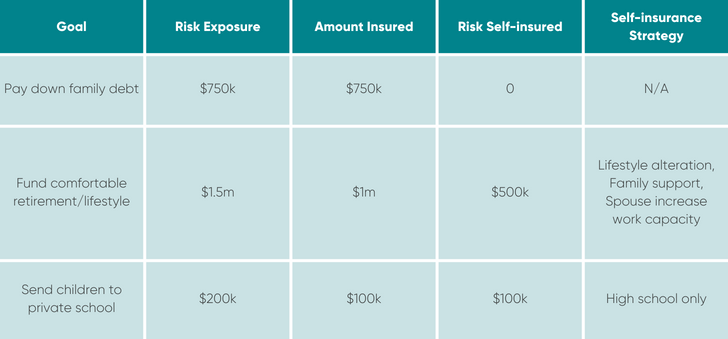When it comes to risk advice, the needs analysis is just the beginning of the conversation. While it’s important to understand where a client’s financial exposure may be, the real magic of personal risk advice comes in the process of personalising the analysis to specific client circumstances.
How do you get sums insured right for your client?
Using a collaborative process to arrive at sum insured amounts can increase client buy-in and fulfil compliance obligations.
Establishing appropriate sum insured amounts for your client is a cornerstone of personalised risk advice. To achieve this, you need to take a broad set of principles and make them relevant to the individual sitting in front of you.
Doing a needs analysis is a vital starting point, but working closely with your client is what will bring your financial advice to life. This insurance philosophy can make you stand out from everyone else. By speaking with and educating your client, you’re more likely to arrive at a personalised solution that delivers peace of mind and understanding for them, and confidence for you that you have it right.
Recommending an appropriate sum insured amount is tied to acting in a client’s best interests under section 961B of the Corporations Act 2001. The Financial Adviser Standards and Ethics Authority (FASEA) emphasises the importance of considering risk advice in the context of a client’s long-term objectives (Standard 6), the client’s understanding of your advice (Standard 5), and that your recommendations are in good faith and not misleading (Standard 9).
For advisers, that means taking a client through a transparent, personalised process. You need to identify the points of vulnerability in your client’s life, quantify their financial value, and arrive at an informed mitigation solution. A philosophy and process based on transparency allows you to meet your professional obligations in a way that benefits and educates your client, rather than simply ticking a box for compliance.
At each step of the process, this philosophy must be guided by the fundamental principle of indemnity. All elements included in the sum insured should be directly tied to compensation for financial loss, and not put the client in a better financial position than if the claimable event had not occurred.
Putting a dollar amount on vulnerabilities
To take your client’s vulnerabilities from identified to quantified, you need a sound rationale for the dollar figure you attach to each line item. Not all philosophies will be the same, but all should be underpinned by one or two objective data points. Those figures show both your client and the regulator the basis for your calculation. Aim to have a sound process here – perfection is unattainable. For example, provisioning for medical expenses could be based on reference to industry white papers, NDIS data, Centrelink data or private health insurance reports. This lets your client see that the dollar amount you attach to each point of vulnerability is grounded in data.
This is not the end of your recommendation, but just the starting point. You should talk with your client about each vulnerability and the consequences if the event occurred. How would your client deal with this? Is there an alternative strategy (for example, self-insurance) they would be comfortable with? This will start to inform the amount to be insured.
Client risk profile and an ability to pay
You’ll need to overlay two more critical elements before you arrive at a final recommendation: client risk profile and ability to pay. You can understand a client’s risk profile by asking qualitative questions about their attitudes, values and beliefs about risk. This informs you on how much they want to be insured for, and how much they’re comfortable self-insuring. A client’s ability to pay will also influence what solution you recommend. The less budget your client is prepared to put towards an insurance solution, the more risk they need to retain via a self-insurance strategy.
What are your client’s other financial objectives?
You must also consider your client’s other financial objectives, as they will affect their ability to pay for insurance. This is highlighted in both the ASIC report 413 and under Standard 6 of the Financial Planners and Advisers Code of Ethics . Those objectives could include retirement savings, paying down the mortgage, investments, private school fees, etc.
You need to remember that every decision your client makes about insuring their risk has a trade-off in other areas of their financial life. You’ll need to carefully weigh these up if you’re to provide truly informed risk mitigation solutions.
Once you have discussed all these considerations with your client, you can present a risk recommendation that outlines to your client their total risk exposure, the amount being insured, the amount being self-insured, and a clear example of the strategy/consequence of that self-insurance decision.
You can use a visual representation, such as the one below, to illustrate this to your client.

Using this approach, you can clearly highlight for your client the trade-offs when you overlay self-insurance, their appetite for risk, and their ability to pay. This way, your advice makes use of a needs analysis that’s based on fundamentally objective data points, which then transitions the numbers into a truly personalised risk recommendation appropriate to your client’s circumstances.
By highlighting the relevance of your suggested solution, and working through a collaborative process, you are likely to increase client buy-in, set them up for longevity and retention, and assist them in managing risk to secure their broader financial goals and objectives.
Learn more about aligning products and sums insured to your client’s needs in Marshall Ross’s two-part webinar series. Reach out to your dedicated BDM to learn how to access on-demand webinar recordings.
Register here.
